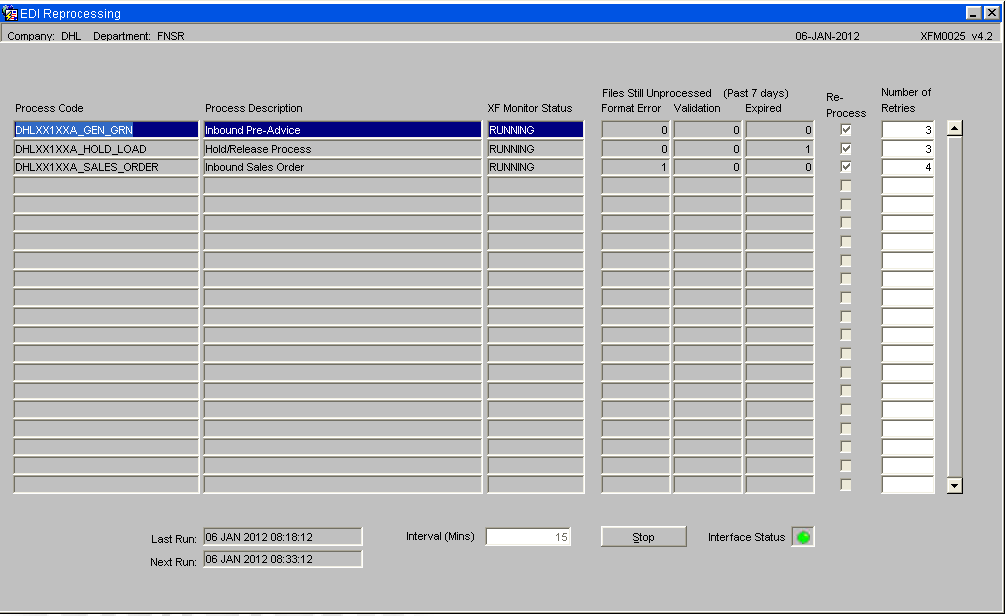UG 352167 C-WMS EDI Setup and Processing Guide
![]()
Aptean
C-WMS EDI Setup and Processing Guide
CALIDUS WMS
30th April 2025 - 2.0
Reference: FS UG 352167
EDI Setup and Processing Guide
INTRODUCTION
This document describes the screens that are required to set up the control data for the EDI Processes in the warehouse. Other guides describe the set up of company, user, warehouse, owners etc.
This is a generic guide based on the version of the Calidus (3pl) system at the time of writing.
Note that fields marked ‘**’ are mandatory and are needed to ensure correct set up of the system.
OVERVIEW
Set up requirements for the use of EDI processes are done in two main stages:
1- Set up of the required general EDI codes for the company level common values (Existing codes are pre-entered when the WMS installed)
- General Codes (PFS0260 & PFS0261)
- EDI Common (EDI0001)
- EDI Last Numbers (INS7050)
2- Addition of the Common records at Owner or Client level and the Configuration of the XF Monitor which is the main EDI engine
- XF Command (XFM0012)
- XF Resequence (XFM0011)
- XF Monitor (XFM0020)
GENERAL EDI CODES – HEADER LEVEL
For each message, you need to set up an EDI code under the heading of ‘EDDI’ in general codes maintenance. These dictate the type of message and what the EDI control number starts with.
NB – These codes should be have been created when the base system is installed.
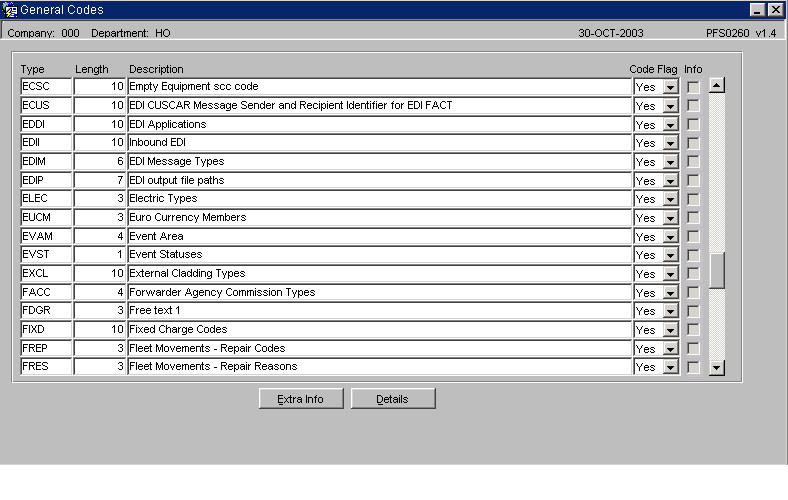
| Field Name | Description | Options | Generic Value |
|---|---|---|---|
| Type ** | The code type you are entering details against | Entry at this level will not be required as these will already have been set up on a company level | EDDI |
| Length ** | The number of characters the sub code has to be | 1 – 9999 | 10 |
| Description ** | A brief description of the type of code | 100 character free text field | EDI Applications |
| Code Flag ** | Is this code to be used by the system | Y or N – default is Y | Y |
| Info | The ability to enter extra information against the code (not migrated) | Blank | Blank |
| Buttons | |||
| Extra Info | The ability to enter additional information, e.g. which screens use this, the purpose of the code etc | Entry at this level will not be required as these will already have been set up on a company level | N/A |
| Details | Takes you into the detail screens for individual entry of each required code | See following | Defined by system setup |
General Codes – Detail Level
For each EDI message required, the code value, description and short description need to be populated. The details to be populated will be described below dependant on the message type.
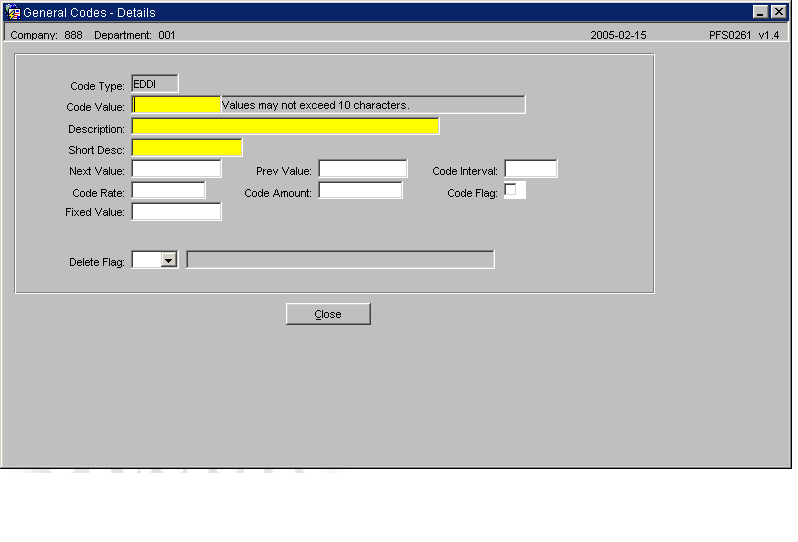
| Field Name | Description | Options | Generic Value |
|---|---|---|---|
| Code Type | The code type the values entered refer to | No entry required as the code type will come through from the header screen | EDDI |
| Code Value ** | The unique identifier for the EDI message required | Defined by the hard coding of each EDI message. he size is determined by the length of the code type entered in the header screen. List of required values below. | See below |
| Description ** | Description of the EDI message being created | 100 character free text field | Defined by the client |
| Short Desc ** | Will determine the first 3 characters of the control number | Defined by the hard coding of each EDI message | See below |
General Codes – Code Types
| Code Value | Description | Short Description | Message Details |
|---|---|---|---|
| OCI | Outbound Commercial Invoice Upload | OCI | An inbound message that updates orders with customs data (cost, country of origin etc)(Client Specific) |
| CII | Inbound Commercial Invoice Upload | CII | An inbound message that updates receipts with customs data (cost, country of origin etc)(Client Specific) |
| PACK | Kewill Carrier Upload | PKI | An inbound message that updates orders with carrier, weight and tracking number information (Client Specific) |
| SRI | Stock Reconciliation Upload | SRI | An inbound message that compares a client’s stockholding figures with the actual values held on the WMS (Client Specific) See below |
| PAI | Pre Advice Upload | PAI | An inbound message that uploads a receipt pre advice into the WMS |
| GRN | Pre Advice Upload | PAI | An inbound message that uploads a receipt pre advice into the WMS |
| PMI | Product Master Upload | PMI | An inbound message that creates stock codes on the WMS |
| STID | Product Master Upload | PMI | An inbound message that creates stock codes on the WMS |
| SOI | Sales Order Upload | SOI | An inbound message that uploads sales orders onto the WMS (Client Specific) |
| SOP | Sales Order Upload | SOI | An inbound message that uploads sales orders onto the WMS |
| HOLD | Hold Upload | Hold | An inbound message that will either hold or release stock quantities |
| WLE | Ware Location Upload | WLE | An inbound message that will create pallet records with associated stock details |
OWNER MAINTENANCE - EDI Inbound & Outbound (Client Specific EDI Configuration)
The following section explains the generation of Sales Order Numbers when using the Sales Order message upload functionality
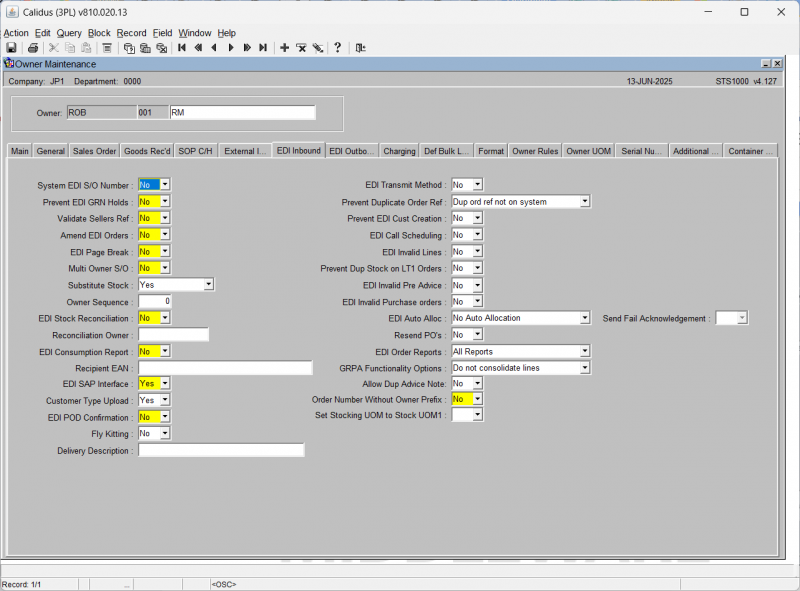
Prevent Duplicate Order Ref:
- ‘Dup Ord Ref not on system’
- The whole file will be rejected if the order exists
- ‘Duplicate Order Ref Allowed’
- The order will be uploaded – if a non-unique order is uploaded multiple times, errors will :occur.
- ‘Upload All Recs Excluding Dups’
- All orders will be uploaded into the EDI transient table. However, the duplicate will be held :with errors.
System EDI S/O Number:
- If Y – the system will generate a unique sequential reference to build the order number.
- If N – The system will use the ‘order reference’ received as part of the order to build the order number.
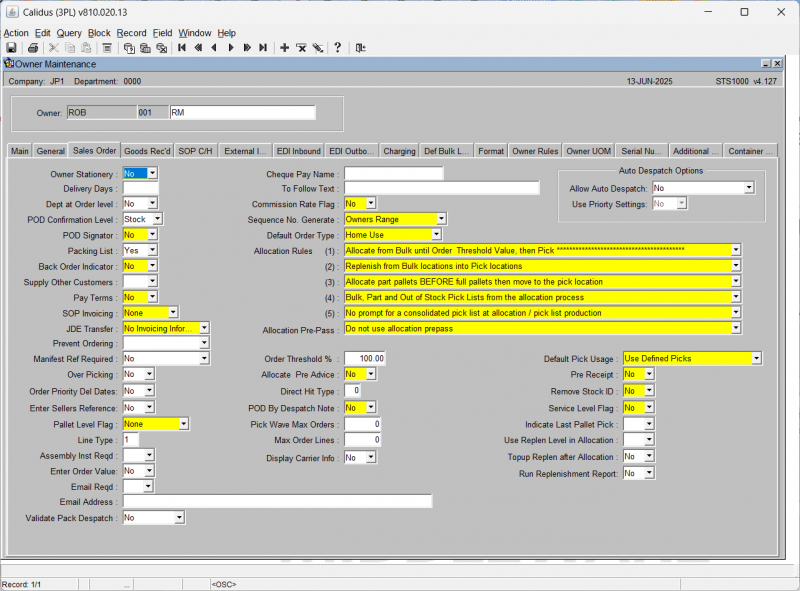
Sequence No. Generate:
- The normal is ‘Owner Range’
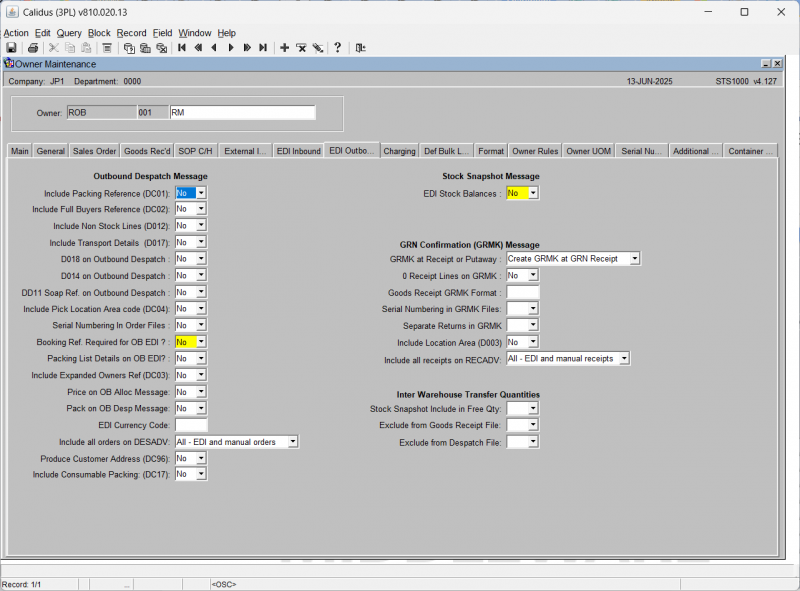
Order Number Without Owner Prefix:
- This may be Yes or No
If EITHER ‘Sequence No. Generate’ or ‘Order Number Without Owner Prefix’ are set to ‘Owner Range’ or ‘N’ respectively, the order number will be 20 characters long. Else it will be either a simply sequential reference or the order reference supplied.
NB Two new values have been added to Owner System Parameters (WHS0012) EDI Setting of Sales Order Number and EDI Sales Order Number Prefix
- Set EDI Setting of Sales Order Number to "Use Sellers order reference"
EDI LAST NUMBERS
EDI last numbers are used to increment each EDI control number by one. These are dictated by the entry in the EDI codes. These numbers are set automatically by the system, so there is no requirement for user configuration.
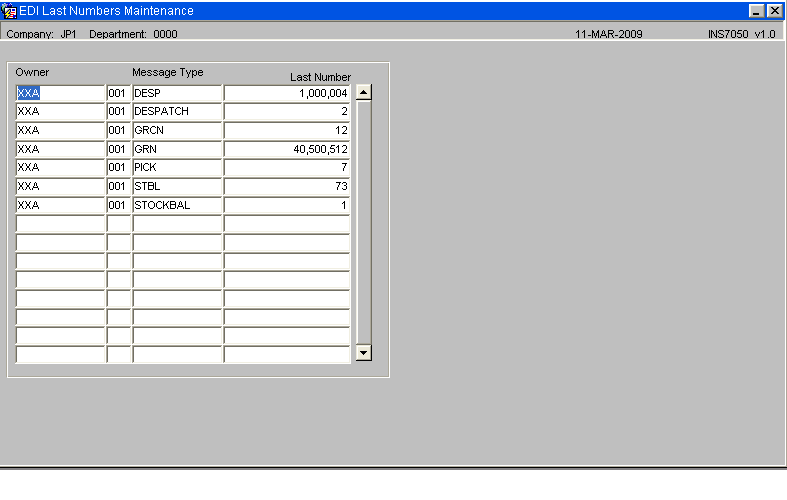
| Field Name | Description | Options | Generic Value |
|---|---|---|---|
| Owner ** | The owner code and sub code the message will be created for | Must have been created in owner maintenance or set to ‘+’ – will automatically create, so all will be set to the owner code of the message | ‘+’ |
| Message Type ** | Based on the values created in EDI common maintenance – a record needs to exist here for each message required | Must have been set up in EDI common maintenance | Defined by the client |
| Last Number ** | The starting number for each EDI message | 0 – 99999 – will start at 0 for each new message | 0 |
EDI COMMON MAINTENANCE
EDI common is used to dictate for what company/warehouse/owner the EDI flows are for.
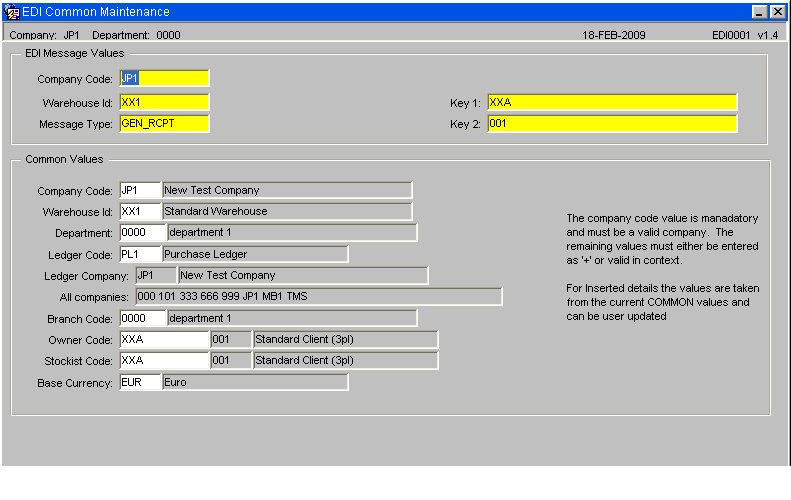
| Field Name | Description | Options | Generic Value |
|---|---|---|---|
| Company Code ** | Company code the user is setting up the EDI for | Must have been created in company maintenance | Defined by the client |
| Warehouse ID ** | The warehouse code the user is setting up the EDI for | Must have been created in warehouse maintenance | Defined by the client |
| Message Type ** | The message type of the EDI flow you are setting up | Defined by the hard coding of each EDI message – available message types listed below | See below |
| Key 1 ** | If the database is to have multiple owners under one warehouse/company combination the owner code for each message will need to be set up here | Owner code of the owner otherwise ‘+’ if only one owner per warehouse using EDI. Advisable to always define the owner code. | Defined by the client |
| Key 2 ** | If the database is to have multiple owners under one warehouse/company combination the owner sub code for each message will need to be set up here | Owner sub code otherwise ‘+’ if only one owner per warehouse using EDI. | Defined by the client |
| Company Code ** | Company code the user is setting up the EDI for | Must have been created in company maintenance | Defined by the client |
| Warehouse Id ** | The warehouse code the user is setting up the EDI for | Must have been created in warehouse maintenance | Defined by the client |
| Department ** | The department code set up against the company | Must have been created in departments maintenance | Defined by the client |
| Ledger Code ** | Determines which area of the system the message relates to | PL1 or SL1 | See below |
| Branch Code ** | The branch code set up against the company (not required) | Must have been set up in branch code maintenance or set to '+' | + |
| Owner Code ** | The owner code and sub code the message is being set up for | Must have been created in owner maintenance | Defined by the client |
| Stockist Code **(same as owner code) | The owner code and sub code the message is being set up for | Must have been created in owner maintenance | Defined by the client |
| Base Currency ** | The default currency code being used by the owner | Must have been created in currency maintenance | Defined by the client |
EDI XF COMMAND
This screen is used to dictate which package is called for each flow. The package id field is user definable, but the ‘Package SQL Code’ is predetermined by the package format.
Once you have entered the package id and the package SQL code, you must then specify whether it is an inbound or outbound flow.
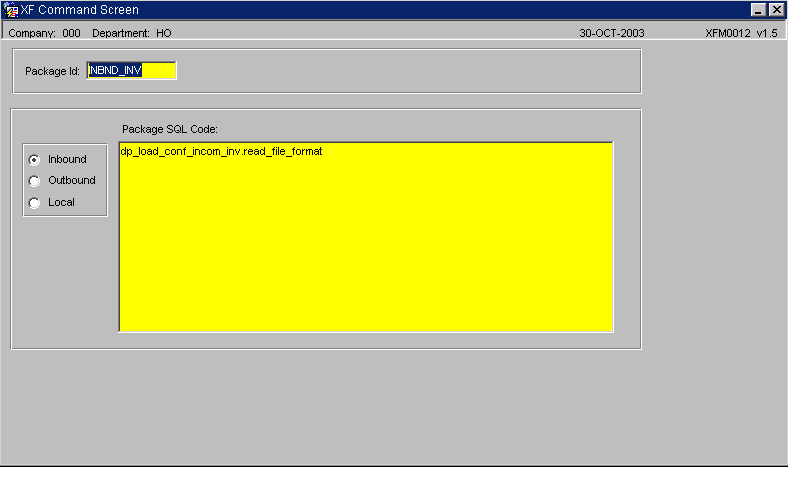
| Field Name | Description | Options | Generic Value |
|---|---|---|---|
| Package Id ** | The unique identifier for this message type – note, you will need to remember this for further setup | 10 character free text field | Defined by the client |
| Inbound/Outbound/Local ** | Specifies whether the message is an inbound or an outbound flow (note, ‘local’ is not used for current WMS implementations) | Check box | Defined by the message type |
| Package SQL Code ** | The programming instruction to determine which package the EDI will call | Defined by the hard coding of the program | Defined by the message type |
EDI Listings and Setup Matrix
Hard-coded EDI outbound messages
| Description | EDI Common Name* | XFM Command Screen** | Process Code*** | Database Package Name | Notes |
|---|---|---|---|---|---|
| Acknowledgement of Hold Release Message | N/a | ACK | User Definable | dp_edigen_out_ack.write_flat_file | - |
| Despatch message (Client Specific) | N/a | DESP | Not required? | dp_edi_out_desp_conf.write_flat_file | Not to be used in future implementations (Included for completness) |
| Generic Receipt Message | N/a | RCPT_CONF1 | GEN_RCPT | dp_edigen_out_receipt_confirm.process_out_recp_confirm | - |
| Returns and Collections | N/a | N/a | RETCOLL | dp_edigen_retcoll.write_file | - |
| Acknowledgement of Allocation | Yes user definable | N/a | Must be same name as used in EDI Common | dp_edigen_out_ack.write_alloc_ack_file | - |
| Allocation Message | N/a | DESP1 | GEN_ALLOC | dp_edigen_out_pdp_conf.write_flat_file | - |
| Cancellation message | N/a | DESP1 | GEN_CANC | dp_edigen_out_pdp_conf.write_flat_file | - |
| Order Details | N/a | DESP1 | GEN_ORD | dp_edigen_out_pdp_conf.write_flat_file | - |
| Generic Pick Message | N/a | DESP1 | GEN_PICK | dp_edigen_out_pdp_conf.write_flat_file | - |
| Generic Hold Message | N/a | DESP1 | GEN_HOLD | dp_edigen_out_pdp_conf.write_flat_file | Order at status 6 being placed on hold |
| Generic Pack Message | N/a | DESP1 | GEN_PACK | dp_edigen_out_pdp_conf.write_flat_file | Fully Packed Order |
| Generic Despatch | N/a | DESP1 | GEN_DESP | dp_edigen_out_pdp_conf.write_flat_file | - |
| Missing Universal Product Code (Barcode information, client specific) | N/a | N/a | MISSING_UPC | dp_edigen_out_missing_upcs.write_flat_file | - |
| Outbound Purchase Ordering | N/a | N/a | POP | dp_edigen_out_pop.write_flat_file | - |
| RDT Stock drip feed of updates | N/a | N/a | RDTSTK | dp_rdt_stock_drip_feed.xf_monitor_send_message | - |
Stock Snapshot Formats
| Description | EDI Common Name* | XFM Command Screen** | Process Code*** | Database Package Name | Notes |
|---|---|---|---|---|---|
| Generic Stock Snapshot | SALES_BAL | SALES GEN
SALES_BAL |
User Definable | dp_edigen_out_st_bal.generate_data
DP_EDIGEN_OUT_ST_BAL.write_flat_file |
Requires two packages to be run in the sequence listed. |
| Stock Snapshot by Rotation | SALES_BAL | STROT_BAL | User Definable | dp_edigen_out_strot_bal.write_file | Requires only one package |
| Stock Snapshot at Detail Level | SALES_BAL | STKDTL_GEN
STKDTL_WRT |
User Definable | dp_edigen_out_st_bal.write_flat_file_dtl
dp_edigen_out_st_bal.write_flat_file_dtl |
Requires two packages to be run in the sequence listed. |
| Client Specific | SALES_BAL | STOCK_GEN
STOCK_BAL |
User Definable | dp_edigen_out_st_bal.generate_data
dp_edigen_out_st_bal.write_flat_file |
Requires two packages to be run in the sequence listed. |
| Client Specific, Serials | SERIAL | STOCK_GEN
STOCK_BAL |
STOCK_BAL_NOV | dp_edigen_out_st_bal.generate_data
dp_edigen_out_st_bal.write_flat_file |
Requires two packages to be run in the sequence listed.
Include the value 'NOV' in the format code field in XF Monitor |
Hard-coded EDI Inbound messages
| Description | EDI Common Name* | XFM Command Screen** | Process Code*** | Database Package Name | Notes |
|---|---|---|---|---|---|
| Booking /Reference Number Update (Client Specific) | BOOK | N/a | BOOK | dp_edigen_book_upd_load.read_file_format | - |
| Hold/Release Process | HOLD_LOAD | N/a | HOLD_LOAD | dp_edigen_hold_load.read_file_format | - |
| Pre-Advice or ASN | GEN_GRN | PRE_ADV | GEN_GRN | dp_edigen_pre_advice_load.read_file_format | - |
| Product Master Upload (Generic) | PRODUCT | PROD_LOAD | User definable | dp_edigen_product_master_load.read_file_format | - |
| Sales Order Upload | GEN_SOP | SOP1 | SALES_ORDER | dp_edigen_sales_order_load.read_sales_order_file | VALUE must be GEN_SOP for standard order file uploads but for XML the system requires another value of SOP to be maintained in the EDI Common.- |
| Sales Kit Upload | User definable, though must be the same name as the Process command in XF Monitor | N/a | User definable, though must be the same name as in EDI Common | dp_edigen_stk_kit_load.read_file_format | - |
Configurable EDI Outbound messages
| Description | EDI Common Name* | XFM Command Screen** | Process Code*** | Database Package Name | Notes |
|---|---|---|---|---|---|
| Adjustment Flow | N/a | N/a | Same name as configurable process | dp_conf_edi_out.produce_dyn_edi_files | - |
| Serial Adjustment Flow | SERIAL | N/a | Same name as configurable process | dp_conf_edi_out.produce_dyn_edi_files | Same setup as above but include the EDI common name to produce serial numbering records. |
Configurable EDI Inbound Messages
| Description | EDI Common Name* | XFM Command Screen** | Process Code*** | Database Package Name | Notes |
|---|---|---|---|---|---|
| SW Average Cost Upload | User definable, though must be the same name as the Configuration process and the Process command in XF Monitor | N/a | User definable, though must be the same name as the Configuration process and the EDI Common record | dp_edigen_sw_upd_load.read_file_format | - |
| Supplier Upload | User definable, though must be the same name as the Configuration process and the Process command in XF Monitor | N/a | User definable, though must be the same name as the Configuration process and the EDI Common record | dp_conf_edi_in.read_edi_supp_file_format | - |
| Customer Upload | User definable, though must be the same name as the Configuration process and the Process command in XF Monitor | N/a | User definable, though must be the same name as the Configuration process and the EDI Common record | dp_conf_edi_in.read_edi_cust_file_format | Option to either upload or amend existing customer records |
| Inbound Hold/Release Process | HOLD_LOAD | N/a | HOLD_LOAD | dp_edigen_hold_load.read_file_format | - |
| Configurable Serial and Translation Number Upload | User definable, though must be the same name as the Configuration process and the Process command in XF Monitor | N/a | User definable, though must be the same name as the Configuration process and the EDI Common record | dp_conf_edi_in.med_seq_xfm | - |
| Stocks Base Selling Price | User definable, though must be the same name as the Configuration process and the Process command in XF Monitor | N/a | User definable, though must be the same name as the Configuration process and the EDI Common record | dp_conf_edi_in.stk_base_sell_xfm | - |
| Stock Region and Sales territory (Client Specific) | User definable, though must be the same name as the Configuration process and the Process command in XF Monitor | N/a | User definable, though must be the same name as the Configuration process and the EDI Common record | dp_conf_edi_in.stock_region_xfm | - |
| Stock, UOM and Barcode information | User definable, though must be the same name as the Configuration process and the Process command in XF Monitor | N/a | User definable, though must be the same name as the Configuration process and the EDI Common record | dp_conf_edi_in.stk_uom_xfm | - |
| Stock Warehouse | User definable, though must be the same name as the Configuration process and the Process command in XF Monitor | N/a | User definable, though must be the same name as the Configuration process and the EDI Common record | dp_conf_edi_in.stock_warehouse_xfm | Putaway anchor points and replenishment levels |
| Updating of existing stock records | User definable, though must be the same name as the Configuration process and the Process command in XF Monitor | N/a | User definable, though must be the same name as the Configuration process and the EDI Common record | dp_conf_edi_in.stock_update_xfm | - |
| Pallet upload (WLE) | User definable, though must be the same name as the Configuration process and the Process command in XF Monitor | N/a | User definable, though must be the same name as the Configuration process and the EDI Common record | dp_conf_edi_in.read_edi_wle | - |
| Pallet upload of held stock | User definable, though must be the same name as the Configuration process and the Process command in XF Monitor | N/a | User definable, though must be the same name as the Configuration process and the EDI Common record | dp_conf_edi_in.wle_held_stock_xfm | - |
| Stock Master Upload | User definable, though must be the same name as the Configuration process and the Process command in XF Monitor | N/a | User definable, though must be the same name as the Configuration process and the EDI Common record | dp_conf_edi_in.read_edi_prod_mast_format | - |
| Configurable stock warehouse | User definable, though must be the same name as the Configuration process and the Process command in XF Monitor | N/a | User definable, though must be the same name as the Configuration process and the EDI Common record | dp_conf_edi_in.stock_locations_xfm | Putaway anchor points and replenishment levels |
Carrier EDI Messages
| Description | Direction | EDI Common Name* | XFM Command Screen** | Process Code*** | Database Package Name | Notes |
|---|---|---|---|---|---|---|
| Carrier Interface - Allocation | Out | N/a | N/a | CICA | dp_cim_outbound.write_cioc_cica_file | - |
| Carrier Interface - Order Confirmation | Out | N/a | N/a | CIOC | dp_cim_outbound.write_cioc_cica_file | - |
| Carrier interface - Package details | Out | N/a | N/a | CIPD | dp_cim_outbound.write_cipd_file | - |
| Manual cancelled orders | Out | N/a | N/a | CANC | dp_cim_outbound.write_canc_file | - |
| POD Confirmation (Ireland Specific) | Out | N/a | N/a | PODC | dp_cim_outbound.write_podc_file | - |
| Carrier interface - Tracking Details | In | CITD | N/a | CITD | dp_cim_inbound.read_file_format | - |
| Carrier Interface - Packing Information | In | CICD | N/a | CICD | dp_cim_inbound.read_cicd_file_format | - |
Miscellaneous EDI Messages
| Description | Direction | EDI Common Name* | XFM Command Screen** | Process Code*** | Database Package Name | Notes |
|---|---|---|---|---|---|---|
| DHL Labels EDI Generation | Out | DHEG | N/a | DHEG | dp_edigen_out_pack_label.write_dheg_file | - |
| DHL Label Tracking Reference | In | DHEG_UPL | N/a | DHEG_UPL | dp_edigen_dheg_upd_load.read_file_format | Will capture a tracking reference number and automatically create pack header records |
Local Processes
| Description | Direction | EDI Common Name* | XFM Command Screen** | Process Code*** | Database Package Name | Notes |
|---|---|---|---|---|---|---|
| Script to automatically allocate all orders in the well | Local | ALLOC | N/a | ALLOC | dp_edigen_alloc.xf_monitor_allocate | - |
| If the order is held in Metapack as status ‘Manifested’, ‘Tracking’ or ‘Complete’, then the EDI process will initiate the WMS despatch process, down-dating the stock and updating the order as despatched. | Local | META_DESP | N/a | META_DESP | dp_edigen_out_metapack.despatch_check | Client specific see MetaPack for setup details |
FTP Processes
| Description | Direction | EDI Common Name* | XFM Command Screen** | Process Code*** | Database Package Name | Notes |
|---|---|---|---|---|---|---|
| In bound FTP process | In | N/a | FTP_INBND | User Definable | dp_process_control_xfm.ftp_inbound | - |
| Out bound FTP process | Out | N/a | FTP_OUTB | User Definable | dp_process_control_xfm.ftp_outbound | - |
NB
EDI Common Name * As a general rule an EDI Common Name is required for all inbound messages but is not a requirement for outbound messages, though there are a couple of exceptions as noted above, i.e. Outbound Serial numbering functionality
XF Command Screen (XFM0012)** These are all user definable, but depending on the system install there may be existing records, as noted above.
Process Code (XFMonitor XFM0020)*** As a rule outbound proceses require a specifed Process Code, the required values are listed above.
XF RESEQUENCE
The XF Re-sequence screen is used if you wish to call multiple packages under one package id. You then specify which package, and in what priority. For example to automatically ftp despatch messages on to a remote server you would set sequence one to run the DESP package and then sequence two would run the outbound ftp package.
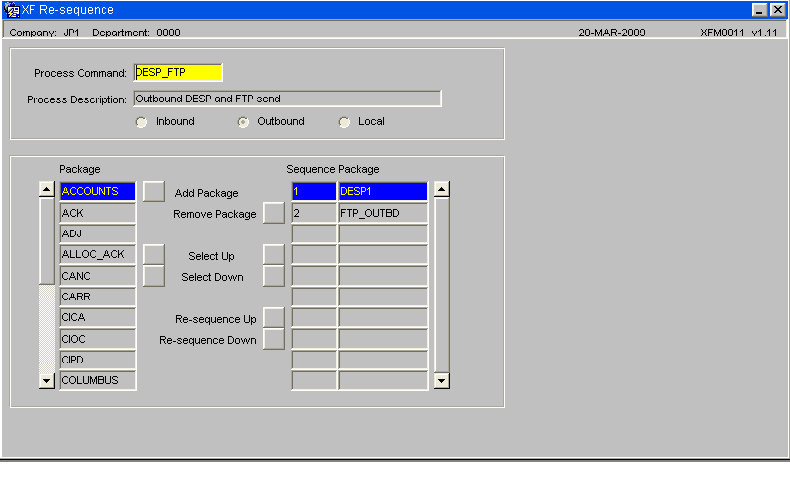
| Field Name | Description | Options | Generic Value |
|---|---|---|---|
| Process Command ** | Based on the package id set up in the previous screen – this will ensure the process calls the correct package | Must have been set up in xf process command | Defined by the client only for Outbound messages, see table below for inbound message naming formats |
| Process Description ** | A brief description of what EDI message the process code relates to | 50 character free text field | Defined by the client |
| Inbound/Outbound/Local ** | Specifies whether the message is an inbound or an outbound flow (note, ‘local’ is not used for current WMS implementations ) | Defined by the message type |
| Buttons | Description |
|---|---|
| Add Package | Adds the selected package to the sequencing pool |
| Remove package | Removes the selected package from the sequencing pool |
| Select Up | Moves the packages up so the one you require is selected |
| Select Down | Moves the packages down so the one you require is selected |
| Re-sequence Up | If more than one selected package in the pool, re-sequences the priorities of the flows (upwards) |
| Re-sequence Down | If more than one selected package in the pool, re-sequences the priorities of the flows (down) |
XF MONITOR
For each EDI flow, you need to set up core information such as which package to run and at what time and frequency. There is also the requirement to enter directory and reporting parameters. These are configured in the XF monitor screen. There are multiple tabs to set up dependent on requirements.
XF Monitor – Setup tab
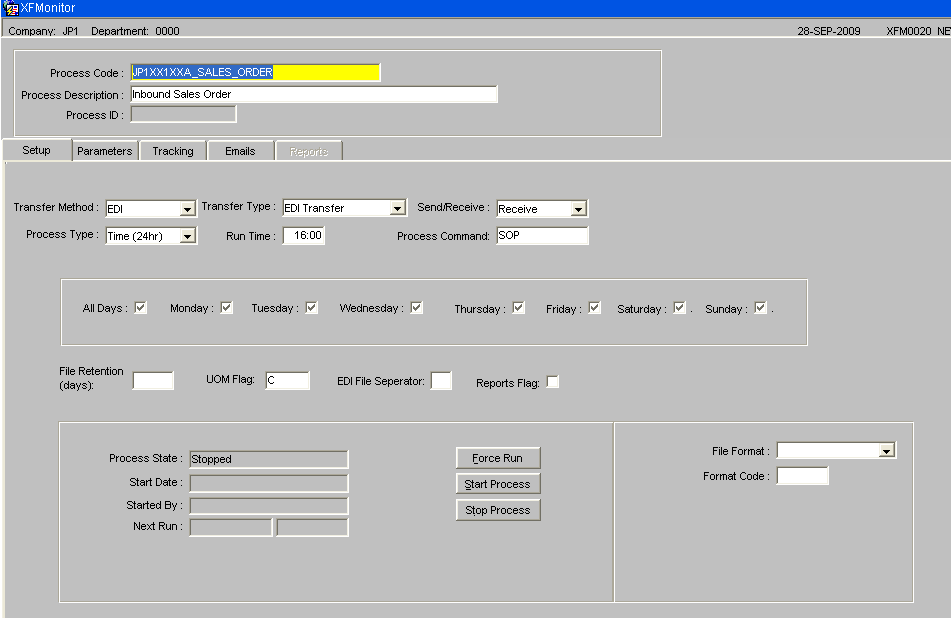
| Field Name | Description | Options | Generic Value |
|---|---|---|---|
| Process Code ** | Uses the process code as specified in xf command/resequence and adds the company, owner and warehouse | Must have been set up in xf command and xf resequence | Defined by the client, but dependent on message flow may require a defined code. See table below. |
| Process Description ** | A description of the process code | 60 character free text field | Defined by the client |
| Process Id | If using EDI running processes, gives the message a unique system generated process id | No entry required – generated by the system | N/A |
| Transfer Method ** | How the EDI will be transmitted | EDI or Non-EDI | EDI |
| Transfer Type ** | Specifies in what format the files will be generated | EDI Transfer / FTP Transfer / Unix Transfer or N/A | EDI or FTP dependent on whether the file will be picked up from a remote server or sent to a remote server. |
| Send/Receive ** | Specifies whether the file is to be received or sent (inbound or outbound) | Send or Receive | Determined by the message |
| Process Type ** | This is where you specify how you want the flow to run and when. If you set the process type to interval – you will need to put in an interval time in the Interval (mins) field – in the example above, this will run every 15 minutes. If you set this to Time (24hr) – you will then be asked for which days and what time. This will cause the flow to run, say every day at 21:00 | Interval / Time (24hr) | Defined by the client |
| Interval (mins)/Frequency | If set to Interval, the number of minutes before the process should start again. If set to Time, you will see a box for a time and every day of the week which can be checked to enable the run at a specific time for specific days | 0 – 999999 | Defined by the client |
| Process Command ** | The package id as entered in the process code at header level | Must have been set up in xf command and xf resequence | Defined by the client |
| File Retention Days | If archiving, the number of days files that will be kept | N/A | N/A |
| UOM Flag (F/S 231470) | Used to allow the WMS system to work in a different UOM than the clients system. | N - No conversion required
C - Convert units to cases U - Convert cases to units R - Convert units to cases round up N - No conversion required||Defined by Client | |
| EDI File Separator | Specifies what delimiters the EDI files will be using, used for configurable messages. | ’ etc | Defined by the client |
| Reports Flag | Specifies whether you wish upload and exception reports to be produced | Yes / No | Defined by the client |
| Process State | Shows whether the EDI message is running on a process or not | Display only – Stopped, Running or Broken | N/A |
| Start Date | If you click the ‘Start Process’ button – this will display the date the process was started | Display only | N/A |
| Started By | The user id of the person who has started the process running | Display only | N/A |
| Next Run | Calculates the date/time the next process will run based on the last run plus the interval | Display only | N/A |
| Inbound File Formats | The format of the incoming file | CSV / Fixed Length / Syspro / Attribute based XML | Defined by the client |
| Element based XML | Defined by the client | N/a | N/a |
| Format code | Defined by the client | N/a | N/a |
| Buttons | Description |
|---|---|
| Force Run | Enables a ‘one off’ EDI poll |
| Start Process | Begins the polling process that will trigger the message to be uploaded/sent at the relevant time. |
| Stop Process | Stops the frequency/interval from running |
NB: Generic EDI flows must have a Process Code (Within XFMonitor, XFM0020) that start with the following string of characters.
| Process Command Must Begin With - | Flow |
|---|---|
| SOP | Sales Order |
| PRE_ADV | GRN Upload |
| PROD_LOAD | Stock Upload |
| GEN_ALLOC | Outbound Sales Order Allocation Message |
| GEN_CANC | Outbound Order Cancellation Message |
| GEN_PICK | Outbound Pick Message |
| GEN_DESP | Outbound Despatch Message |
| GEN_RCPT | Outbound General Receipt |
| SADJ | Outbound Serial Number Adjustment |
| HOLD_LOAD | Inbound Holds |
| ORDMGT | Order Management |
NB: The process command can be any length within the screen limitation, but for i.e. sales orders the process command must be like ‘SOP’, ‘SOP1’ etc
‘1SOP’ will not be seen as a sales order upload.
XF Monitor Parameters Tab
The parameter tab controls the storage and the naming convention of the produced files. If the transfer type is set to FTP within the setup tab then the ftp control fields will be displayed.
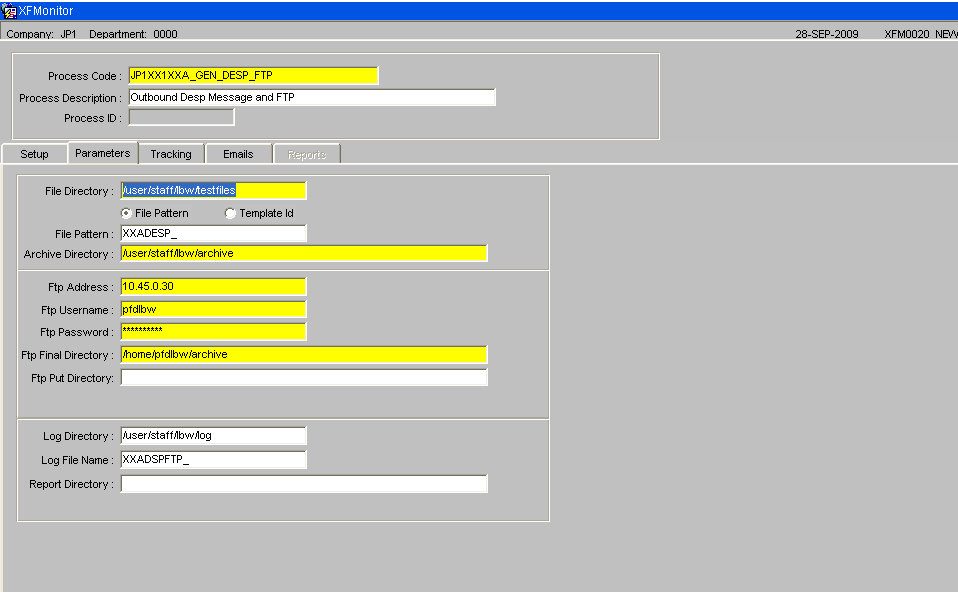
| Field Name | Description | Options | Generic Value |
|---|---|---|---|
| File Directory ** | This is the directory the WMS will search for the message file | This must be a valid directory set up on the Unix box | Defined by the client |
| File Pattern or Template id | File pattern is used for standard EDI messages. For an increased configurable file name then select Template id. Allows for the inclusion of user definable Date/Time stamps etc within the file name format. | File Pattern or Template id | Reference XFM0030 File name construction if template id selected |
| File Pattern ** | The EDI package will upload any file starting with these characters, i.e. as above, anything starting with XXADESP_ | The file pattern will be determined by the system architects who are creating the EDI files | Defined by the client |
| Archive Directory ** | The directory that all processed files will move to | This must be a valid directory set up on the Unix box | Defined by the client |
| FTP Parameters | |||
| FTP Address ** | The I.P. address of the target server | Must be a valid I.P. address that is accessible by the WMS server. | Defined by the client |
| FTP Username ** | User or account name set up on the target server | Must be a valid user id set up on the target server. | Defined by the client |
| FTP Password ** | Password for user or account on target server | Valid password for the username account. | Defined by the client |
| FTP Final Directory ** | Directory where files are to be sent | Valid and accessible account (i.e. permissions must be set to allow files to be copied) | Defined by the client |
| FTP Put Directory | Temporary work directory on the target server | If required it must be valid and accessible. | Defined by the client |
| Log File Settings Directory ** | Which directory all processed log files will be sent to | This must be a valid directory set up on the server | Defined by the client |
| Log File Settings Filename ** | The name of the log file to be produced | Can be any file name the user sets up | Defined by the client |
| Report Directory | Directory name and path where system produced reports will be stored | This must be a valid directory set up on the server | Defined by the client |
XF Monitor - Tracking Tab
An enquiry screen that shows the status of all files that have been processed via the XF Monitor. It also has the function to enquire on files which have failed to upload with the option to resolve errors via the relevant validation screen.

| Field Name | Description | Options | Generic Value |
|---|---|---|---|
| Date Run | Date and Time stamp of when the process ran | Display Only | N/A |
| Process ID | Unique Process identifier assigned when the EDI Process is started or ran using Force Run option. | Display Only | N/A |
| Login Id | User id of the person who ran the process | Display Only | N/A |
| I/O | Inbound or Outbound Indicator | Display Only | N/A |
| Process Detail | Indicates whether the FTP process was called | Display Only | N/A |
| Run Time m/s | The process run time in milliseconds | Display Only | N/A |
| Files Processing | The number of files processed in that particular process run. | Display Only | NA |
| Transient Table Successful / Failed (Inbound Only) | Indicates whether the file was successfully loaded onto the working tables ready for upload into the WMS.(Process checks the physical characteristics of the file. I.E. record length. | Display Only | N/A |
| WMS Successful / Failed | Indicates whether the file was successfully loaded into the WMS. (Process checks mandatory data that is validated within the WMS, such as Owner code or Product code). | Display Only | N/A |
| Buttons | |||
| Control Numbers | Unique number for each file that is uploaded on to the Transient Table | Display Only – Only if the file has failed to upload onto the WMS will a control number be displayed | N/A |
| Filter Data – Show Errors Only / Show all Records / Exclude empty records | All records are displayed in the Tracking Form, the Show Errors button allows for files to be filtered down | Drop down box to make required selection | N/A |
| Date From | Gives the option to enter a past date for the search and retrieval of data up to the present date (system default is 7 days) | N/a | N/a |
| Refresh | To initiate the search | N/a | N/a |
| Errors | Button that will only be displayed if a process is highlighted which is at error. The button will call the relevant validation screen and record for resolution. | N/a | N/a |
XF Monitor - Emails Tab
Email maintenance screen, where you set up the email addresses of any users requiring reports and audit files to be emailed to them.
NB: For the successful production and emailing of reports the database and O/S on the server require the emailing function to be enabled.
Ensure the Reports tick box is enabled on the front tab and the report directories have been created and specified in the Parameters Tab.
Reports are only generated for Inbound Messages.
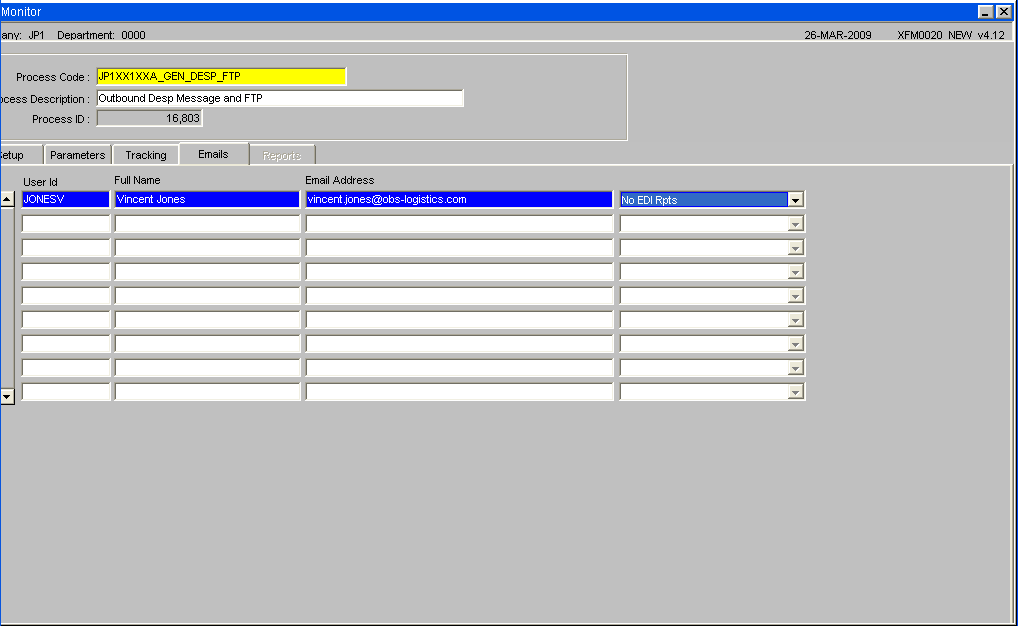
| Field Name | Description | Options | Generic Value |
|---|---|---|---|
| User Id | User id of the person who ran the process as held on the WMS | Must have been set up in user maintenance | Defined by the client |
| Full Names | Full Name of the recipient of the reports | Full name for information purposes | Defined by the client |
| Email Address | Email address where the reports are to be sent | Valid email address | Defined by the client |
| EDI Reports | Required report to be sent via Email | Report Options Include -
No EDI Rpts Audit Statistics Rpt Only Critical Errors Rpt Only Data Errors Rpt Only Audit and Critical Errors Rpt Audit and Data Errors Rpt Critical and Data Errors Rpt All Three Rpts||Defined by the client |
In Addition to the above configuration the system requires additional parameters to be set at server level.
Within System Registry / Global / GeneralSettings the following values must be entered with the relevant data values.
- AppServerConnectString = sce/password@database name
- AppServerFloc = /u02/oraapp/xxx/xxxdev/forms
- AppServerPort = 7777
- AppServerHost = 10.43.0.70 or 127.0.0.1
- AppServerReportServer = repxxxdev
- DefaultDirectory = /tmp
XF Monitor - Reports Tab
Report parameter maintenance screen to specify what kind of reports are to be produced by the system if required and where they are to be sent to.
NB Reports are only generated for inbound messages.
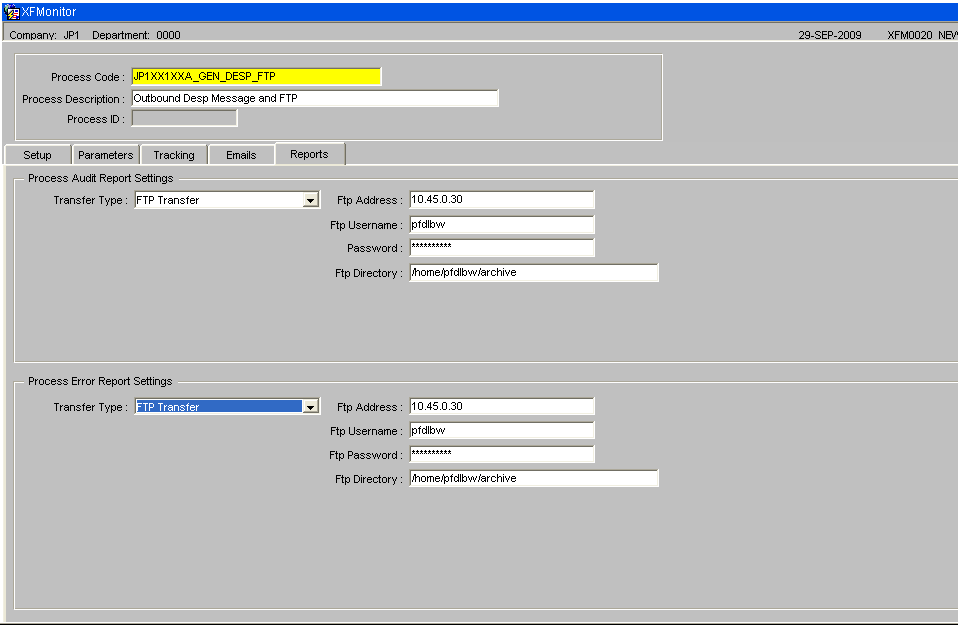
| Field Name | Description | Options | Generic Value |
|---|---|---|---|
| Process Audit Report Settings | |||
| Transfer Type | Option to specify how and where the reports are to be sent. Depending on the option selected additional information will be prompted for. | FTP
N/A Printer Unix File |
Defined by the client |
| Process Error Report Settings | |||
| Transfer Type | Option to specify how and where the reports are to be sent. Depending on the option selected additional information will be prompted for. | FTP
N/A Printer Unix File |
Defined by the client |
VALIDATION SCREENS
For each inbound EDI flow, there is a validation screen. Errors are sequenced by a control number and are displayed in the validation screens where it is possible to rectify the data. Each of the validation screens will differ slightly dependent on the key fields for the message type being accessed.
Validation screens exist for the following processes: -
- GRN Pre- Advice
- Sales Order
- Product Master
- Inbound Holds
- Stock Reconciliation
- Order Management (Client Specific)
- Average Cost
- Stock Kit Validation
- Medical Sequence Validation (Client Specific)
The error records are held in the EDI transient tables until they are validated successfully and the relevant WMS record created at which point they are then cleared down.
Validation Header Screen
Taking the GRN Pre Advice Validation Screen as an example-
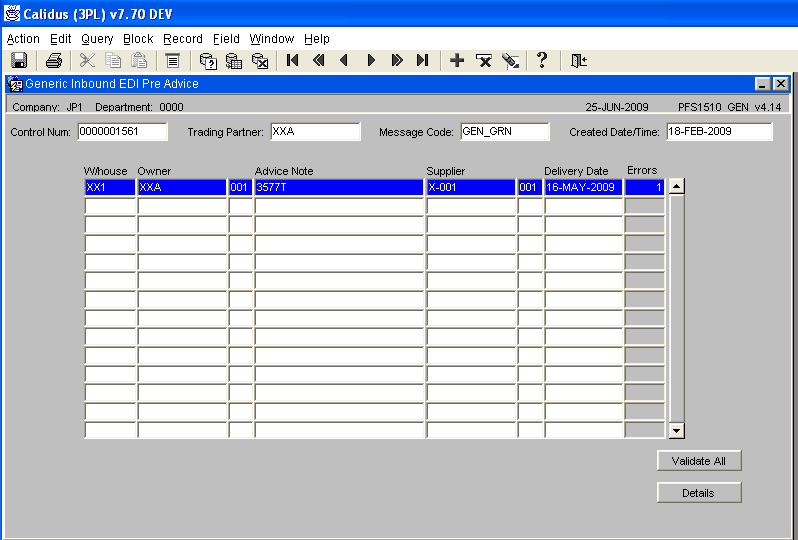
First find the relevant Control Number (Control Numbers are only assigned to messages which have failed to upload)
There is then the option to either -
- Validate All This will re-submit the file to the system in an attempt to re-process it in its entirety . This is only relevant after all errors in the file have been addressed.
- Details will take you in to the body of the message allowing the user to identify the issue within the file and how to resolve it.
Validation Detail Screen
NB The number of tabs within the detail screen and the information displayed will depend on the type of the EDI flow being validated.

The number of errors detected and their description will be displayed in the bottom portion of the form, these will then require resolving before the record can be validated and the record written to the WMS tables. Depending on the type of error this can be achieved by either adding or amending the data within the actual WMS system, or amending the data contained within the file by changing the values directly within the validation form.
Once the errors have been resolved it is then possible to re-submit the message, by selecting the Validate Button . This will only re-process a single record as a time, where if you select Main you will be returned to the top screen where the entire message can be re-submitted and validated.
OUT BOUND RE-SEND SCREENS
If messages have not been generated, have gone missing or require re-transmitting then it is possible to re-generate the message where it will wait for the next out bound ftp process.
Current resend screens: -
- Outbound GRN Confirmation Message
- Outbound Pack Confirmation Message
GRMK Re-send
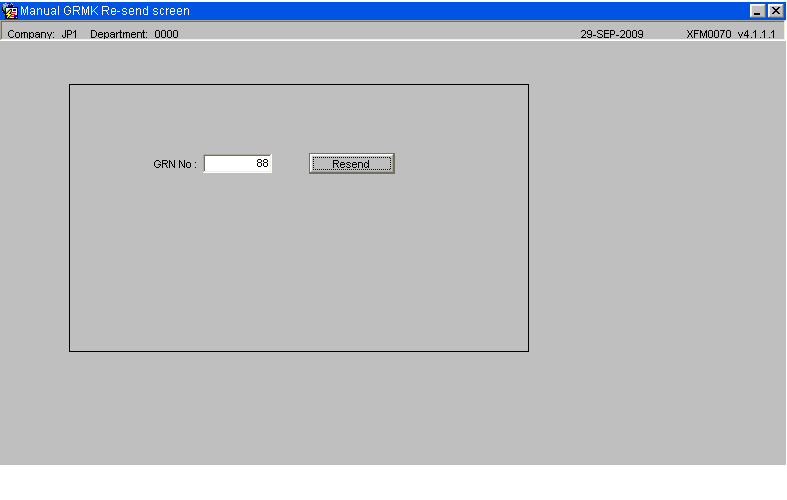
Select the GRN number that requires resending, an LOV is available which will display all closed GRN’s.
Press the Resend button to generate the required message
Packing Details Re-send
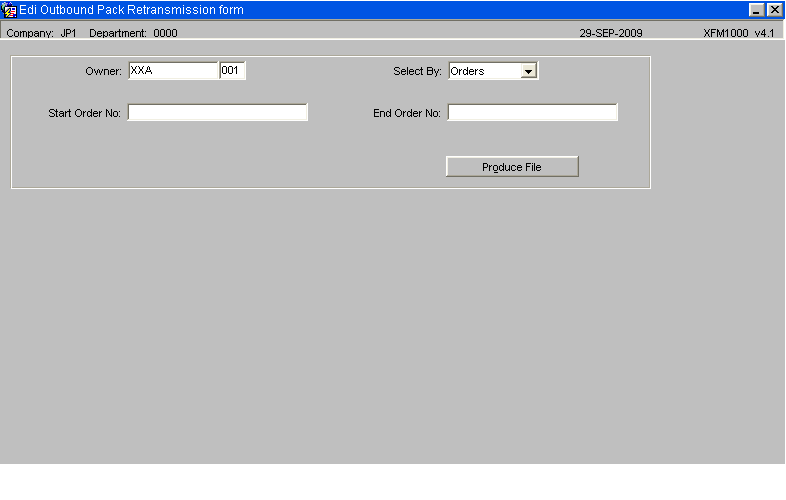
| Field Name | Description | Options | Generic Value |
|---|---|---|---|
| Owner | Owner Code and Sub account id | Default from current user | Defined by the client |
| Select By | Selection criteria for re-transmission | Orders or Despatch Date | Defined by the client |
| Start Order No / End Order No | By Order Number | Order Number From / Order Number To | Defined by the client |
| Despatch Date From / Despatch Date To | By Despatch Date | Despatch Date From / Despatch To | Defined by the client |
CONFIGURABLE EDI SETUP
Dynamic Inbound EDI Message Definition
System Registry (ULF0030)
To produce log files to aid error resolution and to display tracking information within the XF Monitor Tracking page the following system registry setting must be entered at a Global Level 'ConfEdiLogDisplay' with a value of 'Y'
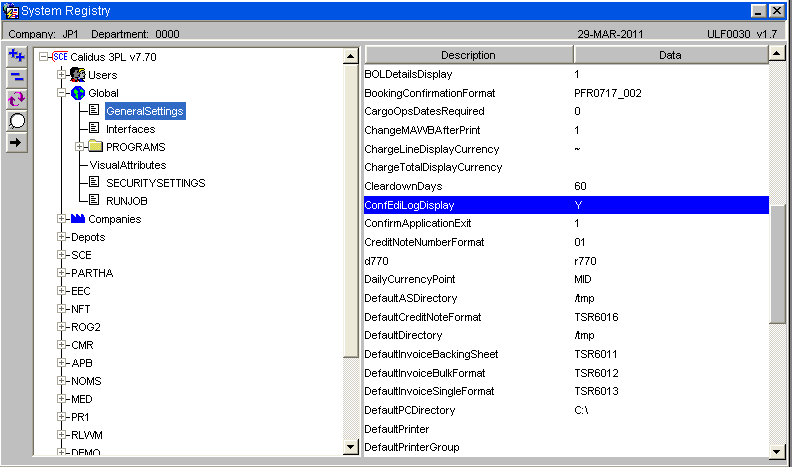
For a list of configurable EDI Messages see - Configurable EDI Inbound Messages
XF Dynamic Inbound EDI Definition Screen (XFM0055)
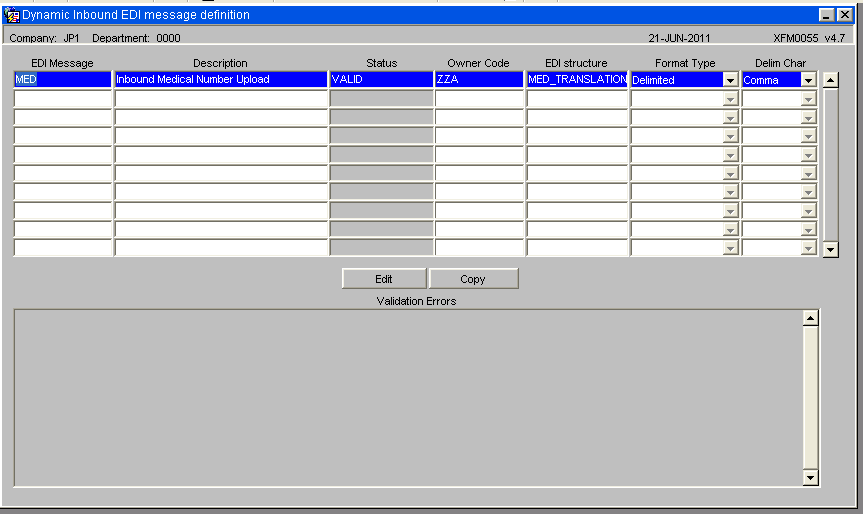
Inbound Configurable Setup (Example)
The following is a description on the steps required to setup an Inbound Configurable message for a Stock Warehouse update.
NB In the example below the process has been named STKWHSE the name is definable, but the same name must be used in the following screens -
- EDI Common Maintenance (EDI0001)- Message Type
- Dynamic Inbound EDI Message Definition (XFM0055) - EDI Message
- XF Monitor (XFM0020) - Process Code
See above for a detailed description of each of the forms.
EDI Common Record (EDI0001)
EDI common is used to dictate for what company/warehouse/owner the EDI flows are for.

| Field Name | Description | Options | Generic Value |
|---|---|---|---|
| Company Code ** | Company code the user is setting up the EDI for | Must have been created in company maintenance | Defined by the client |
| Warehouse ID ** | The warehouse code the user is setting up the EDI for | Must have been created in warehouse maintenance | Defined by the client |
| Message Type ** | The message type of the EDI flow you are setting up | Defined by the hard coding of each EDI message – available message types listed below | See below |
| Key 1 ** | If the database is to have multiple owners under one warehouse/company combination the owner code for each message will need to be set up here | Owner code of the owner otherwise ‘+’ if only one owner per warehouse using EDI. Advisable to always define the owner code. | Defined by the client |
| Key 2 ** | If the database is to have multiple owners under one warehouse/company combination the owner sub code for each message will need to be set up here | Owner sub code otherwise ‘+’ if only one owner per warehouse using EDI. | Defined by the client |
| Company Code ** | Company code the user is setting up the EDI for | Must have been created in company maintenance | Defined by the client |
| Warehouse Id ** | The warehouse code the user is setting up the EDI for | Must have been created in warehouse maintenance | Defined by the client |
| Department ** | The department code set up against the company | Must have been created in departments maintenance | Defined by the client |
| Ledger Code ** | Determines which area of the system the message relates to | PL1 or SL1 | See below |
| Branch Code ** | The branch code set up against the company (not required) | Must have been set up in branch code maintenance or set to '+' | + |
| Owner Code ** | The owner code and sub code the message is being set up for | Must have been created in owner maintenance | Defined by the client |
| Stockist Code **(same as owner code) | The owner code and sub code the message is being set up for | Must have been created in owner maintenance | Defined by the client |
| Base Currency ** | The default currency code being used by the owner | Must have been created in currency maintenance | Defined by the client |
XF Command Screen (XFM0012)
This screen is used to dictate which package is called for each flow. The package id field is user definable, but the ‘Package SQL Code’ is predetermined by the package format.
Once you have entered the package id and the package SQL code, you must then specify whether it is an inbound or outbound flow.

| Field Name | Description | Options | Generic Value |
|---|---|---|---|
| Package Id ** | The unique identifier for this message type – note, you will need to remember this for further setup | 10 character free text field | Defined by the client |
| Inbound/Outbound/Local ** | Specifies whether the message is an inbound or an outbound flow (note, ‘local’ is not used for current WMS implementations) | Check box | Defined by the message type |
| Package SQL Code ** | The programming instruction to determine which package the EDI will call | Defined by the hard coding of the program | Defined by the message type |
EDI Listings and Setup Matrix
Hard-coded EDI outbound messages
| Description | EDI Common Name* | XFM Command Screen** | Process Code*** | Database Package Name | Notes |
|---|---|---|---|---|---|
| Acknowledgement of Hold Release Message | N/a | ACK | User Definable | dp_edigen_out_ack.write_flat_file | - |
| Despatch message (Client Specific) | N/a | DESP | Not required? | dp_edi_out_desp_conf.write_flat_file | Not to be used in future implementations (Included for completness) |
| Generic Receipt Message | N/a | RCPT_CONF1 | GEN_RCPT | dp_edigen_out_receipt_confirm.process_out_recp_confirm | - |
| Returns and Collections | N/a | N/a | RETCOLL | dp_edigen_retcoll.write_file | - |
| Acknowledgement of Allocation | Yes user definable | N/a | Must be same name as used in EDI Common | dp_edigen_out_ack.write_alloc_ack_file | - |
| Allocation Message | N/a | DESP1 | GEN_ALLOC | dp_edigen_out_pdp_conf.write_flat_file | - |
| Cancellation message | N/a | DESP1 | GEN_CANC | dp_edigen_out_pdp_conf.write_flat_file | - |
| Order Details | N/a | DESP1 | GEN_ORD | dp_edigen_out_pdp_conf.write_flat_file | - |
| Generic Pick Message | N/a | DESP1 | GEN_PICK | dp_edigen_out_pdp_conf.write_flat_file | - |
| Generic Hold Message | N/a | DESP1 | GEN_HOLD | dp_edigen_out_pdp_conf.write_flat_file | Order at status 6 being placed on hold |
| Generic Pack Message | N/a | DESP1 | GEN_PACK | dp_edigen_out_pdp_conf.write_flat_file | Fully Packed Order |
| Generic Despatch | N/a | DESP1 | GEN_DESP | dp_edigen_out_pdp_conf.write_flat_file | - |
| Missing Universal Product Code (Barcode information, client specific) | N/a | N/a | MISSING_UPC | dp_edigen_out_missing_upcs.write_flat_file | - |
| Outbound Purchase Ordering | N/a | N/a | POP | dp_edigen_out_pop.write_flat_file | - |
| RDT Stock drip feed of updates | N/a | N/a | RDTSTK | dp_rdt_stock_drip_feed.xf_monitor_send_message | - |
Stock Snapshot Formats
| Description | EDI Common Name* | XFM Command Screen** | Process Code*** | Database Package Name | Notes |
|---|---|---|---|---|---|
| Generic Stock Snapshot | SALES_BAL | SALES GEN
SALES_BAL |
User Definable | dp_edigen_out_st_bal.generate_data
DP_EDIGEN_OUT_ST_BAL.write_flat_file |
Requires two packages to be run in the sequence listed. |
| Stock Snapshot by Rotation | SALES_BAL | STROT_BAL | User Definable | dp_edigen_out_strot_bal.write_file | Requires only one package |
| Stock Snapshot at Detail Level | SALES_BAL | STKDTL_GEN
STKDTL_WRT |
User Definable | dp_edigen_out_st_bal.write_flat_file_dtl
dp_edigen_out_st_bal.write_flat_file_dtl |
Requires two packages to be run in the sequence listed. |
| Client Specific | SALES_BAL | STOCK_GEN
STOCK_BAL |
User Definable | dp_edigen_out_st_bal.generate_data
dp_edigen_out_st_bal.write_flat_file |
Requires two packages to be run in the sequence listed. |
| Client Specific, Serials | SERIAL | STOCK_GEN
STOCK_BAL |
STOCK_BAL_NOV | dp_edigen_out_st_bal.generate_data
dp_edigen_out_st_bal.write_flat_file |
Requires two packages to be run in the sequence listed.
Include the value 'NOV' in the format code field in XF Monitor |
Hard-coded EDI Inbound messages
| Description | EDI Common Name* | XFM Command Screen** | Process Code*** | Database Package Name | Notes |
|---|---|---|---|---|---|
| Booking /Reference Number Update (Client Specific) | BOOK | N/a | BOOK | dp_edigen_book_upd_load.read_file_format | - |
| Hold/Release Process | HOLD_LOAD | N/a | HOLD_LOAD | dp_edigen_hold_load.read_file_format | - |
| Pre-Advice or ASN | GEN_GRN | PRE_ADV | GEN_GRN | dp_edigen_pre_advice_load.read_file_format | - |
| Product Master Upload (Generic) | PRODUCT | PROD_LOAD | User definable | dp_edigen_product_master_load.read_file_format | - |
| Sales Order Upload | GEN_SOP | SOP1 | SALES_ORDER | dp_edigen_sales_order_load.read_sales_order_file | VALUE must be GEN_SOP for standard order file uploads but for XML the system requires another value of SOP to be maintained in the EDI Common.- |
| Sales Kit Upload | User definable, though must be the same name as the Process command in XF Monitor | N/a | User definable, though must be the same name as in EDI Common | dp_edigen_stk_kit_load.read_file_format | - |
Configurable EDI Outbound messages
| Description | EDI Common Name* | XFM Command Screen** | Process Code*** | Database Package Name | Notes |
|---|---|---|---|---|---|
| Adjustment Flow | N/a | N/a | Same name as configurable process | dp_conf_edi_out.produce_dyn_edi_files | - |
| Serial Adjustment Flow | SERIAL | N/a | Same name as configurable process | dp_conf_edi_out.produce_dyn_edi_files | Same setup as above but include the EDI common name to produce serial numbering records. |
Configurable EDI Inbound Messages
| Description | EDI Common Name* | XFM Command Screen** | Process Code*** | Database Package Name | Notes |
|---|---|---|---|---|---|
| SW Average Cost Upload | User definable, though must be the same name as the Configuration process and the Process command in XF Monitor | N/a | User definable, though must be the same name as the Configuration process and the EDI Common record | dp_edigen_sw_upd_load.read_file_format | - |
| Supplier Upload | User definable, though must be the same name as the Configuration process and the Process command in XF Monitor | N/a | User definable, though must be the same name as the Configuration process and the EDI Common record | dp_conf_edi_in.read_edi_supp_file_format | - |
| Customer Upload | User definable, though must be the same name as the Configuration process and the Process command in XF Monitor | N/a | User definable, though must be the same name as the Configuration process and the EDI Common record | dp_conf_edi_in.read_edi_cust_file_format | Option to either upload or amend existing customer records |
| Inbound Hold/Release Process | HOLD_LOAD | N/a | HOLD_LOAD | dp_edigen_hold_load.read_file_format | - |
| Configurable Serial and Translation Number Upload | User definable, though must be the same name as the Configuration process and the Process command in XF Monitor | N/a | User definable, though must be the same name as the Configuration process and the EDI Common record | dp_conf_edi_in.med_seq_xfm | - |
| Stocks Base Selling Price | User definable, though must be the same name as the Configuration process and the Process command in XF Monitor | N/a | User definable, though must be the same name as the Configuration process and the EDI Common record | dp_conf_edi_in.stk_base_sell_xfm | - |
| Stock Region and Sales territory (Client Specific) | User definable, though must be the same name as the Configuration process and the Process command in XF Monitor | N/a | User definable, though must be the same name as the Configuration process and the EDI Common record | dp_conf_edi_in.stock_region_xfm | - |
| Stock, UOM and Barcode information | User definable, though must be the same name as the Configuration process and the Process command in XF Monitor | N/a | User definable, though must be the same name as the Configuration process and the EDI Common record | dp_conf_edi_in.stk_uom_xfm | - |
| Stock Warehouse | User definable, though must be the same name as the Configuration process and the Process command in XF Monitor | N/a | User definable, though must be the same name as the Configuration process and the EDI Common record | dp_conf_edi_in.stock_warehouse_xfm | Putaway anchor points and replenishment levels |
| Updating of existing stock records | User definable, though must be the same name as the Configuration process and the Process command in XF Monitor | N/a | User definable, though must be the same name as the Configuration process and the EDI Common record | dp_conf_edi_in.stock_update_xfm | - |
| Pallet upload (WLE) | User definable, though must be the same name as the Configuration process and the Process command in XF Monitor | N/a | User definable, though must be the same name as the Configuration process and the EDI Common record | dp_conf_edi_in.read_edi_wle | - |
| Pallet upload of held stock | User definable, though must be the same name as the Configuration process and the Process command in XF Monitor | N/a | User definable, though must be the same name as the Configuration process and the EDI Common record | dp_conf_edi_in.wle_held_stock_xfm | - |
| Stock Master Upload | User definable, though must be the same name as the Configuration process and the Process command in XF Monitor | N/a | User definable, though must be the same name as the Configuration process and the EDI Common record | dp_conf_edi_in.read_edi_prod_mast_format | - |
| Configurable stock warehouse | User definable, though must be the same name as the Configuration process and the Process command in XF Monitor | N/a | User definable, though must be the same name as the Configuration process and the EDI Common record | dp_conf_edi_in.stock_locations_xfm | Putaway anchor points and replenishment levels |
Carrier EDI Messages
| Description | Direction | EDI Common Name* | XFM Command Screen** | Process Code*** | Database Package Name | Notes |
|---|---|---|---|---|---|---|
| Carrier Interface - Allocation | Out | N/a | N/a | CICA | dp_cim_outbound.write_cioc_cica_file | - |
| Carrier Interface - Order Confirmation | Out | N/a | N/a | CIOC | dp_cim_outbound.write_cioc_cica_file | - |
| Carrier interface - Package details | Out | N/a | N/a | CIPD | dp_cim_outbound.write_cipd_file | - |
| Manual cancelled orders | Out | N/a | N/a | CANC | dp_cim_outbound.write_canc_file | - |
| POD Confirmation (Ireland Specific) | Out | N/a | N/a | PODC | dp_cim_outbound.write_podc_file | - |
| Carrier interface - Tracking Details | In | CITD | N/a | CITD | dp_cim_inbound.read_file_format | - |
| Carrier Interface - Packing Information | In | CICD | N/a | CICD | dp_cim_inbound.read_cicd_file_format | - |
Miscellaneous EDI Messages
| Description | Direction | EDI Common Name* | XFM Command Screen** | Process Code*** | Database Package Name | Notes |
|---|---|---|---|---|---|---|
| DHL Labels EDI Generation | Out | DHEG | N/a | DHEG | dp_edigen_out_pack_label.write_dheg_file | - |
| DHL Label Tracking Reference | In | DHEG_UPL | N/a | DHEG_UPL | dp_edigen_dheg_upd_load.read_file_format | Will capture a tracking reference number and automatically create pack header records |
Local Processes
| Description | Direction | EDI Common Name* | XFM Command Screen** | Process Code*** | Database Package Name | Notes |
|---|---|---|---|---|---|---|
| Script to automatically allocate all orders in the well | Local | ALLOC | N/a | ALLOC | dp_edigen_alloc.xf_monitor_allocate | - |
| If the order is held in Metapack as status ‘Manifested’, ‘Tracking’ or ‘Complete’, then the EDI process will initiate the WMS despatch process, down-dating the stock and updating the order as despatched. | Local | META_DESP | N/a | META_DESP | dp_edigen_out_metapack.despatch_check | Client specific see MetaPack for setup details |
FTP Processes
| Description | Direction | EDI Common Name* | XFM Command Screen** | Process Code*** | Database Package Name | Notes |
|---|---|---|---|---|---|---|
| In bound FTP process | In | N/a | FTP_INBND | User Definable | dp_process_control_xfm.ftp_inbound | - |
| Out bound FTP process | Out | N/a | FTP_OUTB | User Definable | dp_process_control_xfm.ftp_outbound | - |
NB
EDI Common Name * As a general rule an EDI Common Name is required for all inbound messages but is not a requirement for outbound messages, though there are a couple of exceptions as noted above, i.e. Outbound Serial numbering functionality
XF Command Screen (XFM0012)** These are all user definable, but depending on the system install there may be existing records, as noted above.
Process Code (XFMonitor XFM0020)*** As a rule outbound proceses require a specifed Process Code, the required values are listed above.
XF Re-sequence (XFM0011)
The XF Re-sequence screen is used if you wish to call multiple packages under one package id. You then specify which package, and in what priority. For example to automatically ftp despatch messages on to a remote server you would set sequence one to run the DESP package and then sequence two would run the outbound ftp package.

| Field Name | Description | Options | Generic Value |
|---|---|---|---|
| Process Command ** | Based on the package id set up in the previous screen – this will ensure the process calls the correct package | Must have been set up in xf process command | Defined by the client only for Outbound messages, see table below for inbound message naming formats |
| Process Description ** | A brief description of what EDI message the process code relates to | 50 character free text field | Defined by the client |
| Inbound/Outbound/Local ** | Specifies whether the message is an inbound or an outbound flow (note, ‘local’ is not used for current WMS implementations ) | Defined by the message type |
| Buttons | Description |
|---|---|
| Add Package | Adds the selected package to the sequencing pool |
| Remove package | Removes the selected package from the sequencing pool |
| Select Up | Moves the packages up so the one you require is selected |
| Select Down | Moves the packages down so the one you require is selected |
| Re-sequence Up | If more than one selected package in the pool, re-sequences the priorities of the flows (upwards) |
| Re-sequence Down | If more than one selected package in the pool, re-sequences the priorities of the flows (down) |
XF Dynamic Inbound EDI Definition Screen (XFM0055)
The Configuration screen - where the EDI message name, type and individual message elements are specified.
- Ensure the EDI Message name is the same as the one entered in EDI Common.
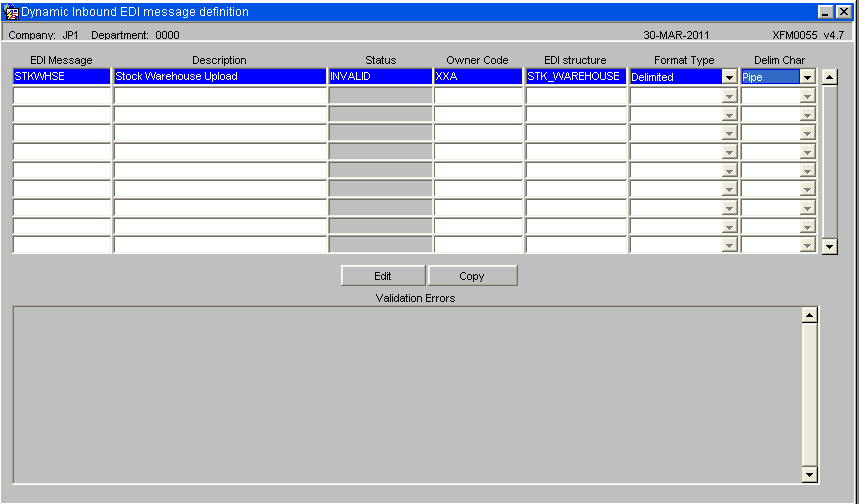
Edit Level Data
Dependent on the chosen format type, ensure that the relevant Field No or Start Positions information is entered.
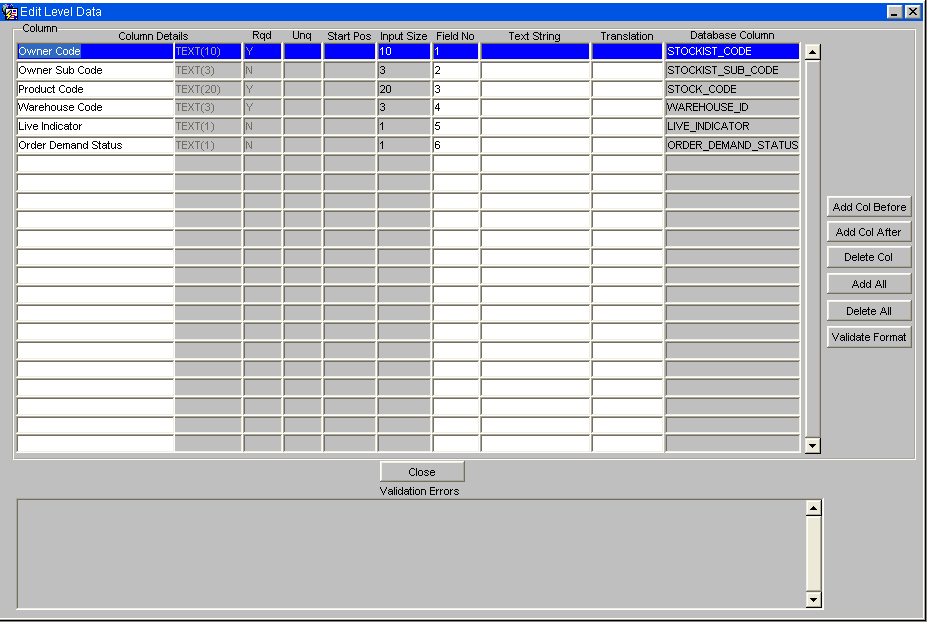
XF Monitor (XFM0020)
Create the XF Monitor record as detailed above.
NB Ensure the name created in the Process Code field is the same as created in EDI Common and the Dynamic Inbound EDI Definition screen.
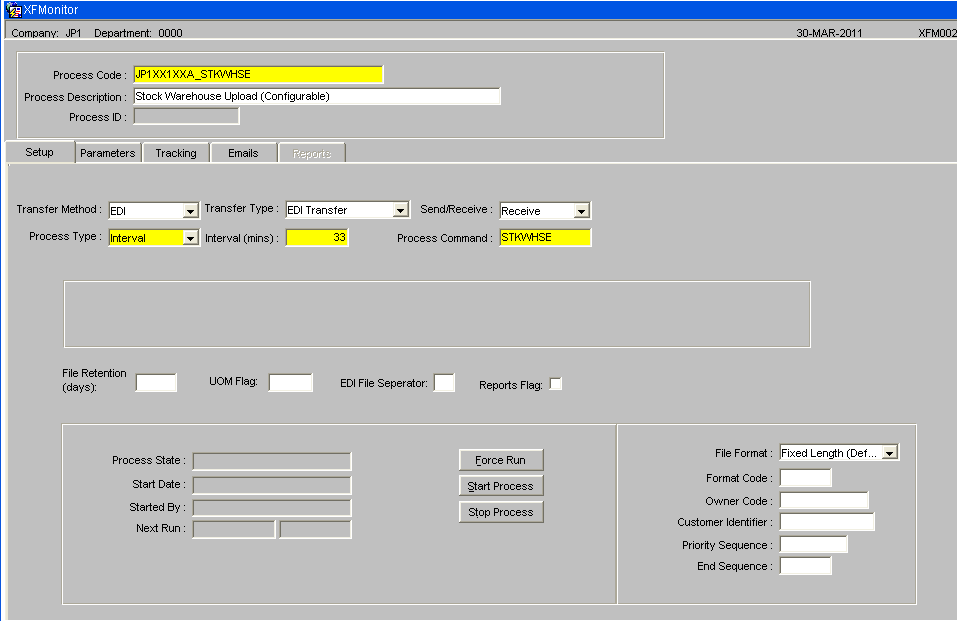
Dynamic Outbound EDI Message Definition
| Field Name | Description | |
|---|---|---|
| Adjustments | Positive and negative adjustments also hold and release | |
| Inventory | Stock Balances | |
| Orders | Order information |
Outbound EDI Message Definition
Filename Construction is a template maintenance screen that allows outbound EDI files to be sent via ftp with a specific filename definition.
If the user defines a filename within the file template form (i.e. ‘IED40430.nnn’ in this case), the outbound ftp process will be altered to check for the existence of filenames of the type ‘IED40430*’. The filename string to search for will be constructed dynamically based on the user-defined elements entered for the template code in question. For this reason, the user will be expected to create template codes with at least one user-defined segment for filenames that are to be ftp’d.
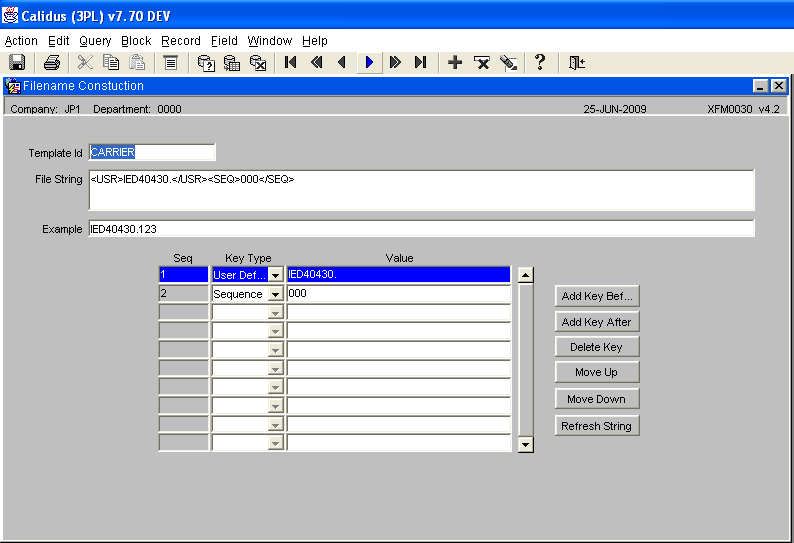
| Field Name | Description | Options | Generic Value |
|---|---|---|---|
| Template Id | Unique name of template | LOV provided for existing templates | Defined by the client |
| File String | an example of how the filename will look | Built up by the system as values are entered in the detail part of the form and then refreshed | Defined by the client |
| Example | Actual Example of file name | Built up by the system as values are entered in the detail part of the form and then refreshed | Defined by the client |
| Seq | Sequence number within file string | Defined by the client | |
| Key Type | Individual file element | Options include- Hard Code, Date, Extension, Separator, Sequence, Time, User Defined | Defined by the client |
| Value | Data element to be displayed | Depending on the key type selected their will either be a relevant LOV or the option of entering free text | Defined by the client |
| Buttons | Description |
|---|---|
| Add Key Before | Insert key into string in front of the selected value |
| Add Key After | Insert key into string after the selected value |
| Delete Key | Delete the key or element from the string |
| Move Up | Move the element up in the string |
| Move Down | Move the element down in the string |
| Refresh String | Will populate the File String and Example filds |
FTP SETUP
FTP Inbound and outbound is executed via a database package the same way as the standard EDI processes. In addition to the calling of the data base packages there is the requirement to set the I.P. address and login details of the remote machine.
It is possible to run the FTP processes standalone or as part of another process.
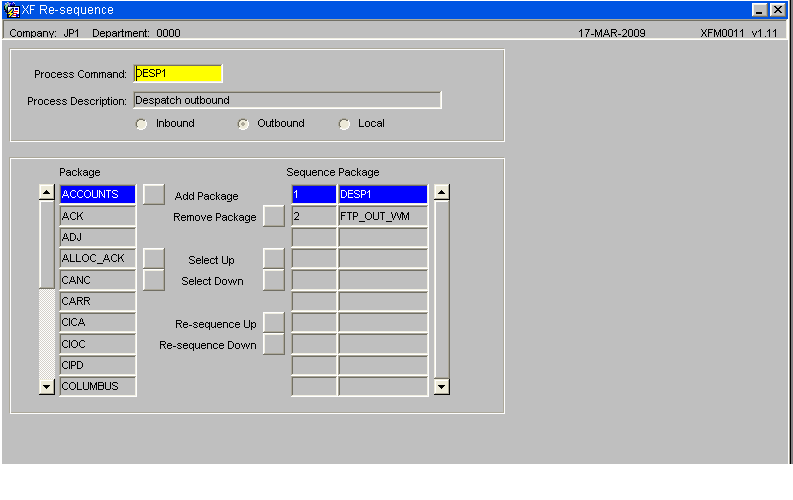
In the above example the process command DESP1 will run consecutively the DESP1 package which will generate the Despatch Messages, followed upon completion by the FTP_OUT_WM package which will the ftp process to which will attempt to place the Despatch files onto the remote machine.
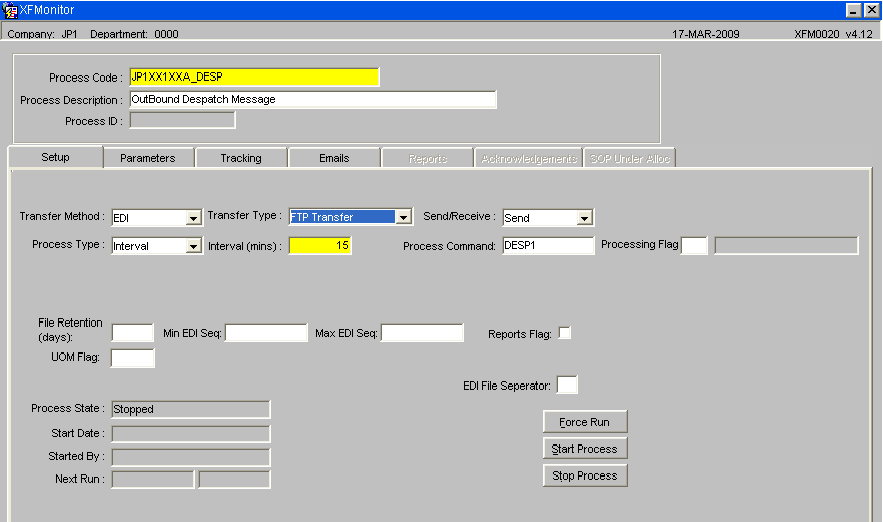
Set the transfer type to – FTP Transfer
EDI Reprocessing
This change will apply to inbound EDI flows only as it refers to the processing of items placed in the transient tables because of a process validation issue.
The current EDI flows that will be included in this change are:
The aim is to reduce the amount of user intervention required when issues like record locking occur during the original data load.
A new screen will list the EDI flows that are setup for the current Warehouse / Owner combination. These EDI flows will appear regardless of whether they are currently running, the screen will display the same flows that can be seen in the XF Monitor screen.
Within this screen there will be option to select each flow. Once a flow is selected, the user must enter the number of times they want each load to be reprocessed and the frequency in minutes between each reprocess run.
If the load reaches the maximum number of re-tries, then it will no longer process automatically but will be available in the usual validation screens for users to validate / update manually.
There will be the option within the screen to start and stop the automatic reprocessing. The users will have to start the process running initially, and then have the option to stop it if required. There will be an indicator on the screen to show if it is currently running.
If the emailing of EDI error reports is set up for the flow, the selected reports will be emailed to the stated users if the load reaches the maximum number of retries.
Appendix A: Document History
A.1 References
| Ref No | Document Title & ID | Version | Date |
|---|---|---|---|
| 1 | |||
| 2 | |||
| 3 |
A.2 Glossary
| Term or Acronym | Meaning |
|---|---|
| Ad Hoc (WCS) | A task instigated on the device (spec. Ad Hoc Pallet Move), rather than a task instigated from the WMS and Stock Control. |
| Advice Note Number | An external reference linked to a Goods Receipt. |
| Aisle (WMS) | A component of a location; usually a space through rows of racking or storage locations; a collection of locations; |
| Allocation (order) | The systemic act of identifying and ring-fencing product matching the order requirements, following proscribed warehouse rules. |
| Anchor Point (WMS) | A starting location for a search for a suitable storage location; auto-putaway location suggestion start point. |
| Area (WMS) | A collection of aisles; an area in the warehouse for a particular purpose. |
| Batch (WMS) | A production batch of a product; a quantity of product that is considered to have the same characteristics; |
| Bay (Warehouse) | A physical loading or unloading point for the warehouse. |
| Bay (WMS) | A component of a location; usually a space between uprights in racking, comprising several levels (horizontal beams). |
| Bay Diary | The mechanism for booking hauliers inbound/outbound and assigning bays. The OBS Logistics system is CALIDUS Bay Diary. |
| Block Stack | A stable stack of pallets. |
| Booking | A time slot for a bay, booked with a Carrier/Haulier. |
| Bulk (WMS) | Bulk storage; Usually full-pallet storage areas, racked or stacked. |
| Cancellation (WCS) | The facility to cancel a task due to some problem, identified by the user when performing the task. |
| Carrier; Haulier | The transport company (by road or sea). |
| Check Digit (WMS) | A short code, usually randomly generated and stored against a location, used to help identify that a user is at the right location before they proceed with a warehouse task. |
| Container | The actual physical container, identified uniquely by the Container Number. The Container will be identified as a Container Type. |
| Container Type | Descriptive of the use and capability and physical characteristics of a container. Container types are 40ft End Loader, Reefer, etc. |
| Container Yard | The storage areas for full and empty locations in the facility. The OBS Logistics system to manage this area is CALIDUS Container Yard. |
| CSV | Character-separated values; a text file with multiple rows and values, usually separated with commas. |
| C-WCS | CALIDUS WCS, the name of the OBS Logistics Warehouse Control system |
| C-WMS | CALIDUS WMS, the name of the OBS Logistics Warehouse Management system |
| Dead Leg (WCS) | A movement of a truck without a pallet; wasted resource. |
| Despatch | The final physical stage of an order; handover of goods to the haulier. |
| De-stuffing | The act of emptying a container and storing the contents in the warehouse. |
| Drive-In | A drive-in location, typically multi-level, multi-deep location. |
| Dry Van | Any type of non-refrigerated container. |
| Dual Cycling | Processes utilizing P&D locations for interleaving tasks in and out of specific areas, reducing dead leg movements. |
| EDI | Electronic Data Interchange; any form of automatically or semi-automatically uploading or downloading information from a computer system without manually re-keying the information. |
| ERP | Enterprise Resource Planning; a system for this. |
| Exchange (WCS) | Specifically Pick Exchange or Task Exchange. The process of allowing a user to select a different pallet in a multi-pallet location and exchanging the expected pallet for this one. If the pallet is planned for another task, task exchange will complete this task instead of the expected one first. If the pallet is not planned, pallet exchange will swap the pallet (if suitable). |
| GR; GRN | Goods Receipt; Goods Receipt Number or Note |
| High Bay | Typically tall (greater than 5 level) racking, usually full pallet storage, usually Narrow Aisle. |
| Inbound (Booking) | A booking linked to a Goods Receipt. |
| JIT | Just In Time; processes designed to trigger at the last instant. |
| KPI | Key Performance Indicator. |
| Level (WMS) | A component of a location; usually the vertical compartments of an area, delineated by horizontal beams. |
| Loading | The act of loading pallets onto a vehicle. |
| Location (WMS) | A uniquely identified space in the warehouse for storage of product. There are many types, most commonly Floor locations (for example, Marshalling, Inbound), Racking or Bulk Storage Locations and Pick faces. |
| Manifest | The contents of a vehicle or container. |
| Marshalling | The act of bringing pallets for an order or load together; an area to do so. |
| Multi-deep | A location with 2 or more pallets stored sequentially i.e. only one can be accessed at a time. |
| NA (WCS) | Narrow Aisle; usually any area in the warehouse that is restricted access due to space limitations, Narrow Aisles have associate P&D locations. |
| Outbound (Booking) | A booking linked to a Sales Order. |
| P&D | Pick-up and Drop-off locations; locations used to control the handover of pallets between distinct areas, for example between chambers and the wider area of the warehouse. |
| PI; Perpetual Inventory | The act of continuously checking locations in a warehouse, identifying and correcting product quantity issues. Usually used in Bulk environments rather than Pick Faces. In pick faces, this process is called is called Residual Stock Balance and usually takes place after picking from a pick face. |
| Pick Face | A location designed for picking part of a pallet of stock. Usually a low- or ground-level location. |
| Pick List (order) | The instructions to pick pallets or cases from locations; the paper report associated to this; the stage of preparing these instructions; the sending of these instructions to WCS. |
| PO | Purchase Order. |
| Pre-advice; Goods Receipt Pre-advice | An advanced notification of what is being received. Part of a manifest. Pre-advices can be stock and quantity, or individual pallet level. |
| Putaway | The physical move of a pallet to a storage location as a result of receiving it into the warehouse. |
| RAG | Acronym for Red/Amber/Green, a traffic light colouration system depicting (in sequence) Errors, Warnings or Informational messages. Usually used in operational monitoring to effectively display when certain processes are not working as expected. |
| RDT | Radio Data Terminal. |
| Reefers | Refrigerated Containers. |
| Replen; Replenishment | The act of moving product (usually a pallet) from bulk storage to a pick face. |
| Reposition (WCS) | The facility to change the location of a movement or putaway when at the final destination, sue to some issue discovered when performing the task. |
| RF | Radio Frequency; An RF device is an RDT, typically used by CALIDUS WCS for executing warehouse tasks. |
| SCR; CR | Software Change Request. |
| Short Allocate | The process of not fulfilling an order due to failure to identify sufficient product at Allocation. |
| Short Pick | The process of not fulfilling an order due to failure to identify sufficient product when picking. May also be used as a term to indicate Short Allocation. |
| SO | Sales Order. |
| Truck Types | Plants, Mechanical Handling Equipment. For example, Reach trucks, Counter-balance trucks, pallet riders, etc. |
| UOM | Unit of Measure. |
| WA (WCS) | Wide Area; usually any area in the warehouse that is not restricted access due to space limitations, for example, floor areas, not Narrow Aisle. |
| WCS | Warehouse Control System |
| WMS | Warehouse Management System |
A.3 Document History
| Version | Date | Status | Reason | By |
|---|---|---|---|---|
| 1.0 | 08/03/2011 | Issue | Initial Version | LBW |
| 2.0 | 30/04/2025 | Issue | Updated version for formatting | ANW |
A.4 Authorised By
Matt Tipping | Aptean Project Manager | _____________________________ |
Tony Walker | Aptean Consultant | _____________________________ |
